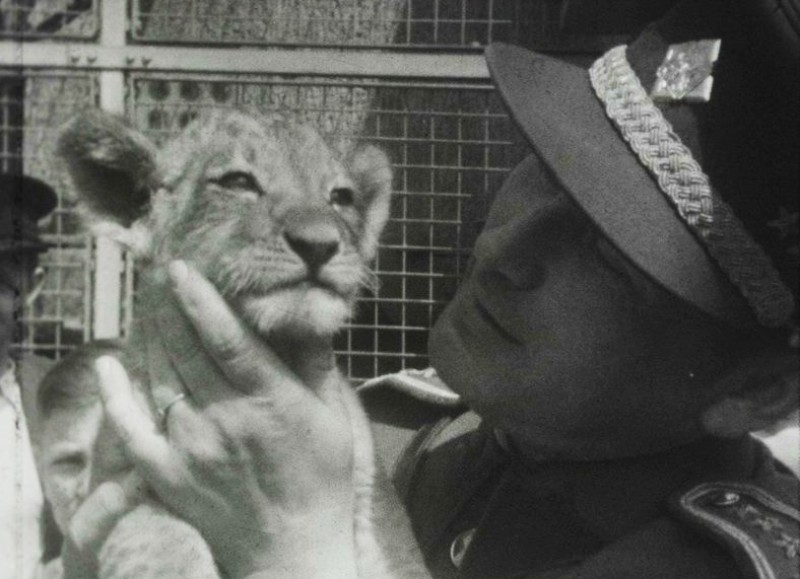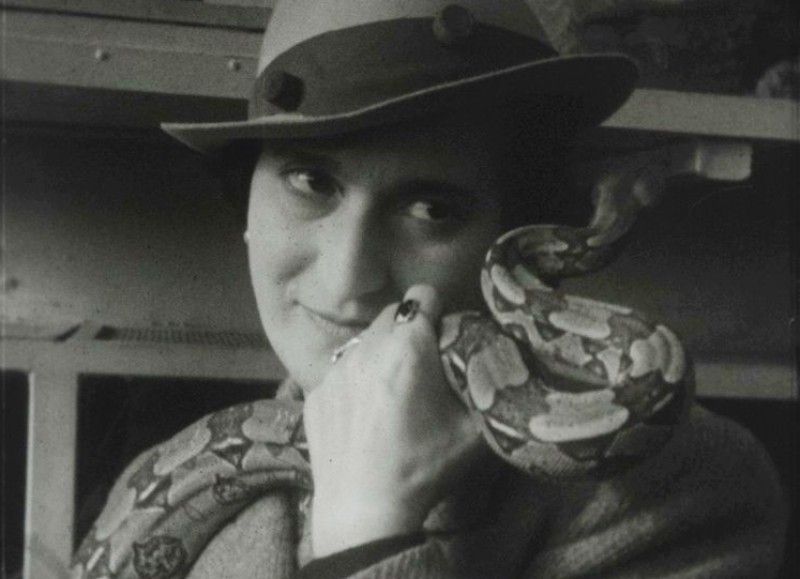Film Collection Insights
"Z" as in Zelinka (Donation)
A collector brought the films to the Austrian Film Museum in 2010 without providing any information about the collection. Special attention is needed when preparing and cataloguing anonymous collections of films for conservation. Without information about their makers or the contexts in which they were made, the only reference points are found in the films themselves: A circled letter "Z" appears as an opening title in the films, an initial indication of the authorship.
Who Are Mr. and Mrs. "Z"?
Two authors can be seen. Both amateur filmmakers film each other at home, on weekend getaways, and at the Prague Zoo. Out of the 13 rolls of film in the collection, eight are devoted to the Prague Zoo. The filmmakers clearly have a familiar relationship to the Prague Zoo, as is also apparent in the title of one film, Rodina a Zvířata (Families and Animals). The amateur filmmaker's close relationship to Jiří and Ludmila Janda initially led us to assume that it might be Jiří Janda's daughter from his first marriage, Jarmila Klatovská. Newly acquired photos of Jarmila Klatovská have subsequently refuted this assumption.
An article by Miroslav Bobek, the current director of the Prague Zoo, provided a deeper glimpse into the history of the zoo's founding and Prof. Janda's involvement in it, and led us to contact Bobek. Our request for help contextualizing and identifying the filming couple resulted in an exciting series of exchanges. The footage is very important for the Prague Zoo. It sheds light on its foundational years and is all the more valuable since a large part of the zoo's archive was destroyed by a flood in 2002.
Two films from the collection show military exercises and weapons tests. The filmmaker frequently steps in front of the camera in uniform, first with three, then with four stars on his collar and cap. Miroslav Bobek consulted military historian Eduard Stehlík, who, based on the collar patch, identified the amateur filmer's uniform as that of a lieutenant colonel in the judicial service of the Czechoslovak Army. Despite intense research, we were initially unable to determine the amateur filmmaker's identity.
On February 23, 2023, a press conference was held at the Prague Zoo during which films and film stills by both film amateurs were presented in order to discover the identities of Mr. and Mrs. "Z" with the help of the Czech media. Media attention for the identification of the two was huge, with newspaper, radio, and TV all covering the search.
At the time of the press conference, Miroslav Bobek was already in contact with the Military History Institute and its curator Milan Hrubý, who provided a list of names with the rank of lieutenant colonel. On this list of over 50 names, one stood out: Josef Zelinka.
The letter "Z" was the first clue that the filmer Mr. Z could be Zelinka. In 1937, Zelinka was promoted to colonel. This matches our observation that first three, then four stars can be seen on the filmmaker's uniform.
Two days after the press conference, Miroslav Bobek's hunch was confirmed: Colonel Zdeněk Horák, a police explosives expert, heard about the call in the media and identified the amateur filmmaker as Josef Zelinka. Further research clarified the name of the other amateur filmmaker: Helena Zelinková.
Bit by bit, more information about the Zelinka film collection has come to light. Josef Zelinka was born in Prague in 1893. He was the Head of the Department of Small Arms and Machine Guns of the 1st Division of the Military Technical and Aerospace Institute. Little is currently known about Helena Zelinková.
Josef Zelinka passed away in 1948. His obituary mentions the films made at the Prague Zoo: "I would not be surprised if the animals in the Prague Zoo are grieving our good friend with us today, and I think that the souls of the cheetahs, Šárka the Lion, and the bumblebee on the shamrock that he filmed with so much devotion, are waiting for him at heaven's gate." (Stefanie Zingl / Translation: Ted Fendt)
We would like to thank the Prague Zoo and especially Miroslav Bobek for his enthusiastic research into the film collection and for initiating the public appeal to identify the two amateur filmmakers.
Při umělém světle (In Tungsten Light)
Josef Zelinka and Helena Zelinková, ČSR [1930-1938], 9.5mm, 39 min, silent
The film Při umělém světle (In Tungsten Light) is an illustration of the couple's collaborative film practice. Both pick up the camera: They film their everyday gestures, they shave and comb their hair, read the newspaper, play chess and the piano, roll cigarettes, and exercise.
Z pražské zoo (Prague Zoo)
Josef Zelinka and Helena Zelinková, ČSR [1937–1938], 9.5mm, 21 min, silent
At the start of the film, we see Helena Zelinková and Ludmila and Jiří Janda. They are in the Prague Zoo's administrative building. Josef Zelinka steps in front of the camera and four stars can be seen on his cap. This limits the date to between 1937, the year that Zelinka was promoted, and 1938, the year that Jiří Janda died.
Josef Zelinka was a member of an amateur filmmaking club in Prague and participated in competitions with his films about the Prague Zoo. To date, three screenings of his films at the Pathé Club have been verified.
Na zahrádce (In the Garden)
Josef Zelinka and Helena Zelinková, ČSR [1933–1938], 9.5mm, 10 min, silent
In addition to the bumblebee mentioned in the obituary, we also see photographer and filmmaker Dr. Václav Jan Staněk (1907-1983). Staněk was the interim director of the Prague Zoo following Jiří Janda's death in 1938. The film was shot using the early color process Dufaycolor, which arrived on the market in 1933. Like a Pointillist painting, the lenticular lens system consisted of tiny points of color that fused in the viewer's eye.
![Z pražské zoo (Prager Zoo), [1937-1938], Josef Zelinka und Helena Zelinková Z pražské zoo (Prager Zoo), [1937-1938], Josef Zelinka und Helena Zelinková](/jart/prj3/filmmuseum/images/cache/b38191b31c4eb532ed4a2483d9eaa669/0x8EC7F84109A0A0CB10F5E29D012DC300.jpeg)
![Při umělém světle (Bei künstlichem Licht), [1930-1938], Josef Zelinka und Helena Zelinková Při umělém světle (Bei künstlichem Licht), [1930-1938], Josef Zelinka und Helena Zelinková](/jart/prj3/filmmuseum/images/cache/36cd29760d5118baa7f53644ab6f918c/0x9E619698997D315AE4D0C5F0229AE437.jpeg)
![Z pražské zoo (Prager Zoo), [1937-1938], Josef Zelinka und Helena Zelinková Z pražské zoo (Prager Zoo), [1937-1938], Josef Zelinka und Helena Zelinková](/jart/prj3/filmmuseum/images/cache/24325a08ca3e51f18db0e9250e6840a8/0xCB789571F193BEBFAAB97C8BB82FE773.jpeg)
![Na zahrádce (Im Garten), [1933-1938], Josef Zelinka und Helena Zelinková Na zahrádce (Im Garten), [1933-1938], Josef Zelinka und Helena Zelinková](/jart/prj3/filmmuseum/images/cache/bdb0310aaa333949a21d3c762a9fe3ca/0xBE0BD14E015EF515C6CABCA0D9DB6756.jpeg)


![Při umělém světle (Bei künstlichem Licht), [1930-1938], Josef Zelinka und Helena Zelinková Při umělém světle (Bei künstlichem Licht), [1930-1938], Josef Zelinka und Helena Zelinková](/jart/prj3/filmmuseum/images/cache/c21a0f486b35368cd4bf50332854eb9c/0x9E25CA8E11866143C571B166E0101F6A.jpeg)
![Z nedelních výletu (Sonntagsausflüge), [1935-1938], Josef Zelinka und Helena Zelinková Z nedelních výletu (Sonntagsausflüge), [1935-1938], Josef Zelinka und Helena Zelinková](/jart/prj3/filmmuseum/images/cache/4f6f2de03c2c44155a9f59be269ec17e/0xA2ED21635E5AC3D6B3072E99EE3BAF48.jpeg)